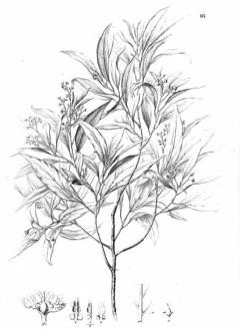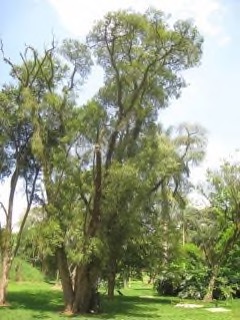 |
|
http://www.edibleplants.org |
 |
| Daderot wikimedia.org |
Translate this page:
Summary
Also grown as an ornamental tree, Ocotea porosa or Imbuia is highly valued for its timber and commonly harvested from the wild. It is slow-growing but highly exploited, thus now considered to be a 'Vulnerable' species in the IUCN Red List of Threatened Species. It is a semi-deciduous, natural pioneer which can be used in restoration of native woodland. It grows about 40 m in height and 1.8 m in trunk diameter, with an open and oblong crown and short bole. The wood is fragrant, moderately heavy, hard, and durable, and resistant to dry wood borers, fungi, and termites. Its is used in carpentry, panelling, sleepers, bridges, turnery, etc.
Physical Characteristics

 Ocotea porosa is a deciduous Tree growing to 18 m (59ft) by 16 m (52ft) at a slow rate.
Ocotea porosa is a deciduous Tree growing to 18 m (59ft) by 16 m (52ft) at a slow rate.
See above for USDA hardiness. It is hardy to UK zone 10.
Suitable for: light (sandy), medium (loamy) and heavy (clay) soils and prefers well-drained soil. Suitable pH: mildly acid, neutral and basic (mildly alkaline) soils. It cannot grow in the shade. It prefers moist soil.
UK Hardiness Map
US Hardiness Map
Synonyms
Cinnamomum porosum (Nees & Mart.) Kosterm. Nectandra dubia Hassl. Nectandra speciosa Chanc. Oreodaph
Plant Habitats
Edible Uses
References More on Edible Uses
Medicinal Uses
Plants For A Future can not take any responsibility for any adverse effects from the use of plants. Always seek advice from a professional before using a plant medicinally.
None known
References More on Medicinal Uses
The Bookshop: Edible Plant Books
Our Latest books on Perennial Plants For Food Forests and Permaculture Gardens in paperback or digital formats.

Edible Tropical Plants
Food Forest Plants for Hotter Conditions: 250+ Plants For Tropical Food Forests & Permaculture Gardens.
More

Edible Temperate Plants
Plants for Your Food Forest: 500 Plants for Temperate Food Forests & Permaculture Gardens.
More

More Books
PFAF have eight books available in paperback and digital formats. Browse the shop for more information.
Shop Now
Other Uses
Furniture Pioneer Wood
Agroforestry Uses: Although slow growing, the tree is a natural pioneer that also provides food for the native fauna[419 ]. It can be used in planting schemes for the restoration of native woodland[K ]. Other Uses The heartwood can be of varied colours, mainly ranging from yellow-brown to a dark brown with irregular, thin, darker layers; it is clearly demarcated from the 3 - 6cm wide band of sapwood. The texture is fine; the grain straight or interlocked; the surface is irregularly lustrous and smooth; there is a pleasant scent. The wood is moderately heavy, moderately hard; fairly durable, even when exposed to the elements, being resistant to dry wood borers and moderately resistant to fungi and termites. It seasons slowly, with only a slight risk of checking or distortion; once dry it is stable in service. It works well with ordinary tools, nailing and screwing are good; gluing is correct. A beautiful wood that is highly valued for the manufacture of luxury furniture, it is also used to make parquet blocks, luxury joinery, carpentry, turnery, panelling, stairs, and for external purposes such as sleepers, bridges and stakes[419 , 848 ].
Special Uses
Attracts Wildlife
References More on Other Uses
Cultivation details
Grows best in a sunny position[419 ]. A slow-growing tree[419 ].
References Carbon Farming Information and Carbon Sequestration Information
Temperature Converter
Type a value in the Celsius field to convert the value to Fahrenheit:
Fahrenheit:
The PFAF Bookshop
Plants For A Future have a number of books available in paperback and digital form. Book titles include Edible Plants, Edible Perennials, Edible Trees,Edible Shrubs, Woodland Gardening, and Temperate Food Forest Plants. Our new book is Food Forest Plants For Hotter Conditions (Tropical and Sub-Tropical).
Shop Now
Plant Propagation
Seed -
Other Names
If available other names are mentioned here
Brazilian-walnut, imbuia - Portuguese, canela-imbuia, embuia, umbuia - Portuguese (Brazil), pocota.
Native Range
SOUTHERN AMERICA: Brazil (south), Paraguay (east)
Weed Potential
Right plant wrong place. We are currently updating this section.
Please note that a plant may be invasive in one area but may not in your area so it's worth checking.
Conservation Status
IUCN Red List of Threatened Plants Status : Status: Vulnerable A1cd

Growth: S = slow M = medium F = fast. Soil: L = light (sandy) M = medium H = heavy (clay). pH: A = acid N = neutral B = basic (alkaline). Shade: F = full shade S = semi-shade N = no shade. Moisture: D = dry M = Moist We = wet Wa = water.
Now available:
Food Forest Plants for Mediterranean Conditions
350+ Perennial Plants For Mediterranean and Drier Food Forests and Permaculture Gardens.
[Paperback and eBook]
This is the third in Plants For A Future's series of plant guides for food forests tailored to
specific climate zones. Following volumes on temperate and tropical ecosystems, this book focuses
on species suited to Mediterranean conditions—regions with hot, dry summers and cool, wet winters,
often facing the added challenge of climate change.
Read More
Expert comment
Author
(Nees & Mart.) Barroso
Botanical References
Links / References
For a list of references used on this page please go here
A special thanks to Ken Fern for some of the information used on this page.
Readers comment
| Add a comment |
|
If you have important information about this plant that may help other users please add a comment or link below. Only comments or links that are felt to be directly relevant to a plant will be included. If you think a comment/link or information contained on this page is inaccurate or misleading we would welcome your feedback at [email protected]. If you have questions about a plant please use the Forum on this website as we do not have the resources to answer questions ourselves.
* Please note: the comments by website users are not necessarily those held by PFAF and may give misleading or inaccurate information.
To leave a comment please Register or login here All comments need to be approved so will not appear immediately.
|
|